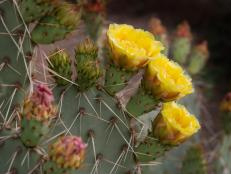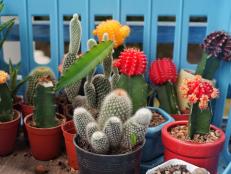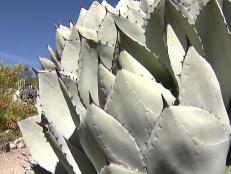Step Lightly Around a Cactus

Worst case scenario for a cowboy is to be bucked off a horse and land in a big patch of cholla (cho-ya) cactus. Cowboy or no, you haven't lived until you've pulled a cholla spine out of your forehead with a pair of needle-nose pliers.
Mother Nature was perfect in her design of this cactus — also dubbed "jumping cholla" — because the spines seem to leap into anything that comes close enough. Under magnified observation, the reason is clear. Each inch-long spine is covered with sharp microscopic barbs as densely as a fish has scales. This allows spines to enter flesh at the lightest touch, then the barbs cling tenaciously against removal.

In the Southwest, victims of cholla and prickly pear, a relative, are seen by emergency room doctors on a routine basis. Perhaps it has now evolved into urban legend or perhaps it occasionally remains fact, but it's said that even today the deeply rooted spines aren't always removed immediately because the barbs can cause horrendous tissue damage as they come out.
Instead, the victims are sometimes left to suffer for a few days until the body produces puss, a reaction to the foreign objects, around the spine. Once this slippery substance cloaks the embedded spine, it will come out easily and with far less scarring.

Cactus spines are actually leaves that evolved to serve a purpose other than food production. Some cactus spines are so dense they shade the cactus skin from intense desert sun. Others are strictly for protection against foraging wildlife.
Cholla spines have barbs for yet another purpose. In the wild, these plants are often sterile, so reproduction by seed is rare. Instead, they reproduce by hitchhiking. The cigar-shaped segments are very weakly jointed, so that they break off at the slightest pressure.
If an animal or cowboy, or even a rubber-shoe sole, gets too close, the cholla spines grab the flesh and hold on, then are unwittingly carried to a new location by the temporary host until they eventually fall off and quickly take root.
If you are unlucky enough to be one who gives a cholla a ride, be prepared. Nothing short of needle-nose pliers will pull them out.

Problems of contact dermatitis are common wherever the fruits of prickly pear cactus are gathered. A cousin of the cholla, this plant also has large sharp spines, but it's the secondary spines, called glochids, that are the banes of workers' existence. Tiny and hair-like, they appear to be harmless fuzz, but they are highly irritating to the skin. Glochids can break off, leaving the tip embedded in your skin. This causes a rash and, in more extreme cases, infections.
Experts suggest using a magnifying glass and tweezers to remove them promptly, one by one, taking care not to cause further breakage.

Getting stuck by popular golden barrel cactus can actually hurt more. The cacti have been tested for thorn toxicity, but none exists. Still, the spines come encased in microscopic sheaths that often remain in the flesh after the spine is removed. There it irritates surrounding tissue until the body finally absorbs the material.
If you experience dermatitis from glochids or spines, experts recommend cortisone creams. Fresh aloe or aloe gel is also an excellent natural treatment that can lessen the redness and speed healing. Be aware that microscopic tips too small to see may remain embedded in your skin, however, and can cause long-term irritation.
Just remember to step lightly around all cacti ... and keep your hands to yourself.
(Maureen Gilmer is a horticulturist and host of Weekend Gardening. For more information, visit www.moplants.com.)










































